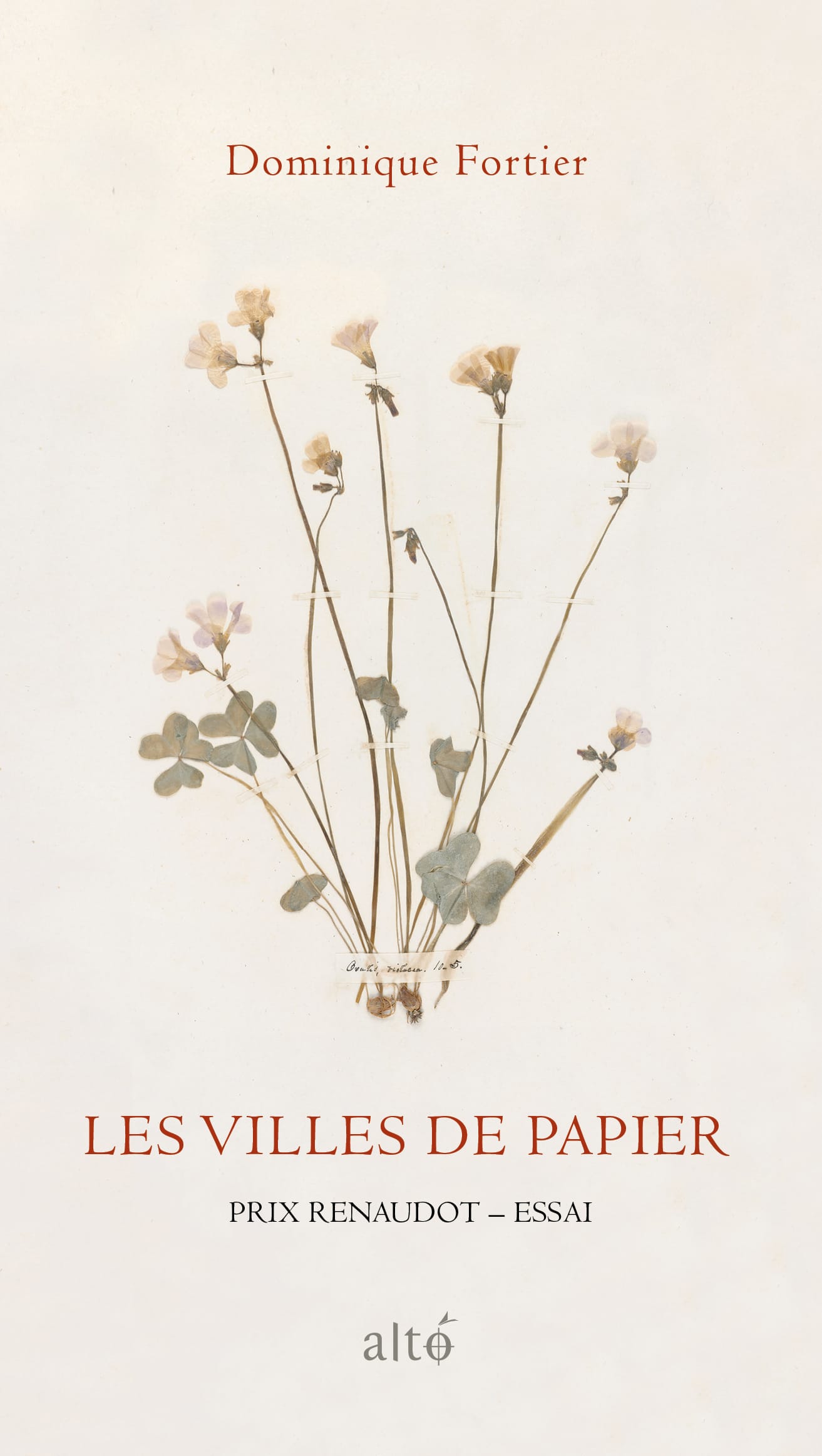Dominique Fortier, Les villes de papier
Fortier’s Les villes de papier is expertly crafted, the vignettes enthrallingly curated, and the impact of the story comprehensively calculated for maximum effect.

Les villes de papier (Éditions Alto, 2018) by Dominique Fortier was a book I picked up in Montreal some time before flying to Poland for the holidays late last year.
It is a prize-winning essay, in French, about Emily Dickinson, which casts her into a limpid prose dramatization of her life, based on her letters, poems and the author’s exploration of her archival documents, combining styles and approaches in a way no anglophone academic would ever dare to attempt.
It reads literarily but hurries along like a Dickinson poem, in fact, almost like a roman de gare, and I must admit I read half of it at the airport and the other half in bed in a snow-surrounded blok apartment bedroom in Poland (and he didn’t know a soul (or body) within a thousand miles).
The cover is a flower pressing from her archival works at Harvard’s Houghton Library.
On that note, I felt compelled to write this review tonight (despite not being entirely sure how to cross the language barrier) because of a post shared by rob mclennan on Instagram this evening via the Dickinson Museum in Massachusetts. It reads:
On April 9, the Emily Dickinson Museum received notice that a grant from the Institute of Museum and Library Services, a federal agency, had been terminated the preceding day. In 2023, the Museum was awarded a grant of $117,000 by IMLS to digitize records related to its newly catalogued collection and to locate related information in other repositories with Dickinson family materials. The notice states, “IMLS has determined that your grant is unfortunately no longer consistent with the agency’s priorities and no longer serves the interest of the United States and the IMLS Program.”
Our work to amplify Emily Dickinson’s revolutionary poetic voice – by opening her family homes to visitors, by interpretive and educational use of her family’s material legacy, by holding up her enduring poetry – continues with support from the Museum’s friends and our unending gratitude.
With all things happening south of the border, including pulling funding from the institutions which maintain these archives, research and vital digitization efforts, disappearing student activists for employing their First Amendment rights, and unconstitutionally deporting visa holders and knowingly mischaracterizing them as criminals in the process, I cannot think of a more vital time for the works of Emily Dickinson, for poetry which inspires the freedom of mind and expression so characteristic of what makes America and the many people who make it worth knowing.
If you haven’t been concerned or outraged about the increase in book bans ratcheting up across the states over the last decade, now’s the next best time to commiserate in the overwhelm of anti-intellectualism and nefarious (when is it anything but really?) villainization of literature that has been underway since well before the former Trump administration took place.
Dominique Fortier (née 1972) is a Quebecker novelist and translator in possession of a PhD in French Literature from McGill. She has most recently translated Anne Michaels, Heather O’Neill, Beatrix Potter, and Emma Hooper. She has published 35 works with Alto and 7 with Éditions du Boréal in Quebec, among others, according to Wikipedia at time of writing.
The book was printed on Rolland Enviro Opaque Offset, rescuing the equivalent of 19 trees, saving six cubic metres of water, and preventing the waste of 1257 kilos of CO₂ and 7 kilos of air emissions.
Also, in the back of the book stands this Note de l’auteure [editor’s note: translations all my own —J.M.]:
If you’re a Canadian who’s ever had a solitary moment in the solitude of nature, say on a cloudless winter day full of sun and without wind in some minor forest that stretches the bounds of what’s considered acceptable public walking space for city life, including some errant electrical poles and uninviting embrasures or marshes, perhaps; or, after a relentless day of unforgiving summer heat, you finally emerge from the shade of the foliage to a mellowing sunset over the horizon in the monochromatic gravel parking lot of a long-since abandoned public park, thankful to be free of daylight at last; then stretch that quiet moment out you had beforehand at the crossroads between continuing the trail and finally going home into an event horizon that spans a lifetime, and you begin to approach something akin to the poetic existence of Emily Dickinson.
“But “Dickinson” cannot be a solipsistic set of meanings,” I should add (Werner, 2017. Emily Dickinson: Manuscripts, Maps, and a Poetics of Cartography, page 99).
For Dickinson, life is not merely just an idyllic nature interlude. As Fortier puts it, it was also very much une vie de papier.
Now seems as good a time as ever to explain the title, too:
— Tu vois, pour se rendre d'Amherst à Boston, explique Austin à Emily, il faut traverser Springfield, Leicester, Worcester, Linden, Waltham.
Du doigt, Emily suit sur la carte les villes en enfilade en prononçant les noms à voix haute.
— Sauf que celle-là, dit Austin en montrant Linden, elle n'existe pas.
Emily lève les yeux sans comprendre. Le nom est imprimé dans le même caractère que les autres, les cartes ne mentent pas.
— Elle n'existe que sur la carte, précise Austin. Je le sais, j'ai fait le chemin vingt fois. Il n'y a là qu'un petit bois et des champs de maïs. Pas même une cabane.
— Mais comment cela est-il possible? demande Emily.
— C'est une ville de papier. Les gens qui ont dessiné la carte l'ont inventée de toutes pièces afin de s'assurer que personne ne leur volerait leur travail.
— Voler une ville, quelle drôle d'idée, fait remarquer Emily.
— Voler non pas une ville, mais son nom, et son tracé, la corrige Austin. Si d'aventure les fabricants de cette carte-ci découvrent la ville de Linden sur une autre carte, ils auront la preuve qu'on a copié leur ouvrage.
— Une ville de papier, répète Emily.
— You see, to get from Amherst to Boston, Austin explained to Emily, you’ve gotta cross Springfield, Leicester, Worcester, Linden, then Waltham.
Emily traced the names of the towns on the map with her finger in transit, uttering them out as she passed over them.
— Except that town, said Austin, pointing out Linden, it doesn’t exist.
Emily lifted her gaze without understanding. Its name was printed in the same type as the others, maps didn’t lie.
— It doesn’t exist except on the map, Austin clarified. I would know, I’ve made the trip twentyfold. There’s nothing there but cornfields and a little patch of trees. No cabin even.
— How so? asked Emily.
— It’s a paper town. The people who drew the map came up with it spur of the moment to make sure nobody stole their work.
— What a silly idea, to steal a town, Emily remarked.
— I don’t mean stealing a town, but its name and location, Austin corrected her. If, perchance, the makers of this map encountered the town of Linden on another map, they would have proof that somebody else had forged their creation.
— A paper town, Emily recapitulated.
This is the addictive, languid, yet fast-paced dialogue and narration that grants Fortier’s work its charm.
The stylistic choices and familiarization of the material very much remind me of my first time reading Nicolas Dickner’s Nikolski (2005) 15 years ago, another Quebec author Fortier has collabed with in Révolutions, a work of terrifyingly cold calculation and Borgesian mystique.
Her storytelling also matches the pacing of the Barcelonian writer Enrique Vila-Matas, with the same distended sense of unreliable narrator since we’re dealing with a historical mise en scène of a particular version of Emily Dickinson that only lives in the mind of the author herself.
Even if your French is a little rusty, Les villes de papier makes for a remarkably fabulous read. Without any hesitation, Fortier illuminates a wealth of manuscript and epistolary material hitherto, for the most part, digitized and hermeticized by scholars but never taken out to play with. She has truly produced a marvel of modern scholarship and literary experimentation that makes good on our collective curiosity for the materially underappreciated Dickinson.
We did not have the sources accessibly archived until very recently.
I write this with mildly quickening breath: I hope the rogue, Davidian spirit of archivists prevails yet again against the gonflé Goliath of American fascism en vigueur. But you can never really hold your breath on things like this.
And if you sense your sympathy waning, or you can’t possibly get interested in Dickinson again at a time like this, I implore you to read Dominique Fortier if you can.
Fortier’s Les villes de papier is expertly crafted, the vignettes enthrallingly curated, and the impact of the story comprehensively calculated for maximum effect.
Bibelotages Newsletter
Join the newsletter to receive the latest updates in your inbox.



